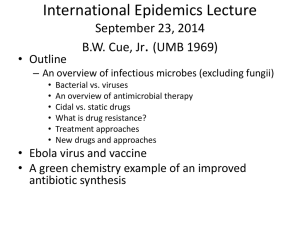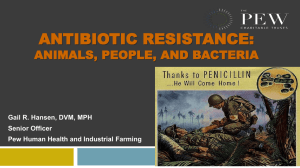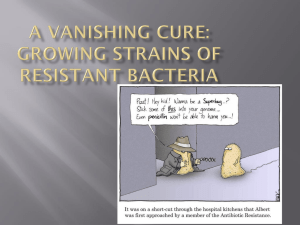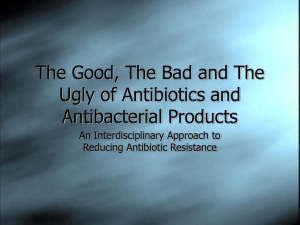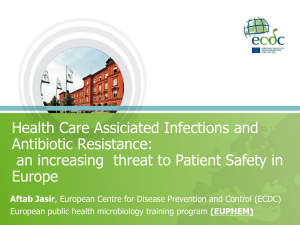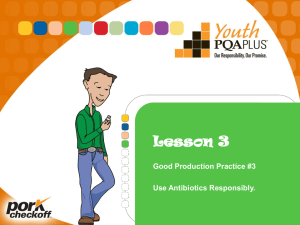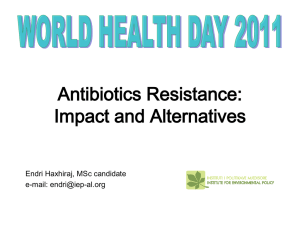Acquired resistance
advertisement
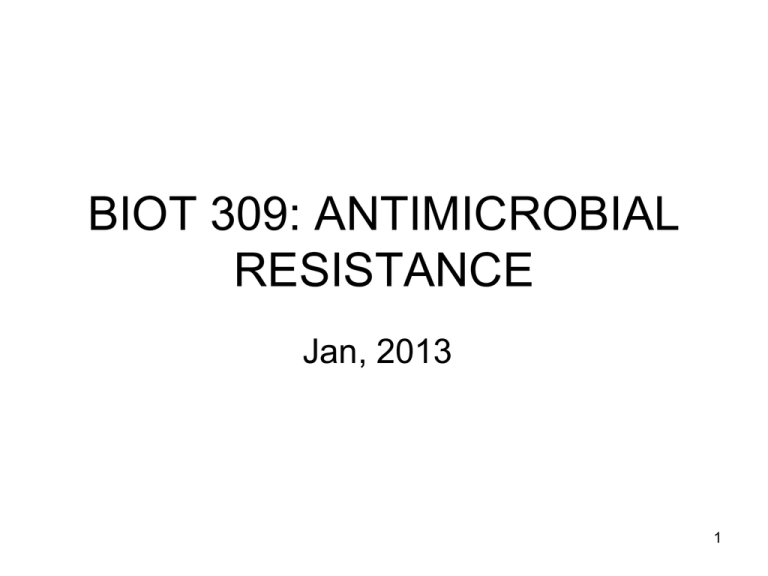
BIOT 309: ANTIMICROBIAL RESISTANCE Jan, 2013 1 2 http://courses.washington.edu/medch401/pdf_text/401_05_black_betalactams.ppt#5 Antibiotic Resistance • Major health challenge • WHY: inappropriate use of antibiotics in hospitals and the community – Treating patients with viral infections with antibiotics (common cold, flu, viral pneumonia, viral gastroenteritis) – Using broad spectrum rather than narrow spectrum antibiotics – Using new, special antibiotics to treat infections when an older antibiotic would be effective • Use of antibiotics to improve growth & production in animals 3 We are running out of new classes of antimicrobials Antimicrobial class • Sulphonamides • Penicillins • Tetracyclines • Chloramphenicol • Aminoglycosides • Macrolides • Glycopeptides • Streptogramins • Quinolones • Oxazolidinones • Cyclic lipopeptides • Ketolides • Glycylcyclines Year of launch 1936 1940 1949 1949 1950 1952 1958 1962 1962 2001 2003 2004 2005 1969 – US Surgeon General said “It is time to close the book on infectious diseases.” 4 The resistance “crisis” • No new classes of antibiotics in the pipeline • Already resistance emerging to newly released antimicrobials • Community acquired MRSA an emerging problem • Now facing untreatable Gram-positive & Gram-negative infections 5 Evolution of drug resistance in S. aureus Penicillin Methicillin S. aureus 1950s Penicillin-resistant S. aureus 1970s Methicillin-resistant S. aureus (MRSA) Vancomycin 1997 Vancomycin -resistant S. aureus (VRSA) 2002 Vancomycinintermediate S. aureus (VISA) 1990s Vancomycin-resistant enterococci (VRE) 6 MMWR Morb Mortal Wkly Rep 2002;51:565–567 Emergence of resistance in Gramnegative bacteria • 1960s – Resistance in E coli and its relatives started to emerge • These rapidly developed resistance to ampicillin, early cephalosporins, aminoglycosides • Multi-drug resistant (MDR) G-ves major problem in hospitals in 1970s and 1980s • More antibiotics (aminoglycosides, extended spectrum lactamases, -lactam/ -lactamase-inhibitor combinations, fluoroquinolones) – worked for awhile • 2000 - extended spectrum -lactamase producing Gram-negatives (ESBLs) – untreatable infections 7 What enables a bacterium to become resistant to an antibiotic? • Some organisms are naturally resistant to some classes of antibiotics (natural or intrinsic resistance) • Mutation continually occurring in bacterial genomes (all genomes!) • Mutation of key genes important to the action of an antimicrobial can result in resistance in that organism to that antimicrobial • This resistance may evolve before the organism has been exposed to that antimicrobial • So, resistance determinants that have always been present in bacteria – Antibiotic producing strains of bacteria (note that resistance genes have been found in antibiotic preparations …) – Soil and gut organisms – Bacterial housekeeping proteins, e.g., efflux pumps 8 How does antibiotic resistance come about? • Use of antibiotics selects out the (low) number of resistant strains – they multiply – the sensitive strains die out – the population of bacteria is resistant ……. • So, antibiotic resistant strains of bacteria emerge under the selection pressure from use of antibiotics 9 Campaign to Prevent Antimicrobial Resistance in Healthcare Settings Selection for antimicrobialresistant Strains Resistant Strains Rare Antimicrobial Exposure Resistant Strains Dominant 10 • Bacteria lurking in soil in the 1960s and 70s resist an antibiotic that didn't exist then. • Three strains of what amount to future-predicting bacteria showed extreme resistance to six common antibiotics, including ciprofloxacin, which was first sold in 1989. • One strain of soil bacteria was even able to fend off a dose of ciprofloxacin that would be lethal to humans. • Developed such defenses as part of the evolutionary arms race that has been going on for billions of years between soil-dwelling microbes. •Many antibiotics drugs come from naturally occurring molecules produced by soil bacteria and fungi, • Some drugs, such as Cipro (the brand name of ciprofloxacin), developed in lab. Scientists examined 3 strains from company that stocks thousands of frozen bacteria •two Klebsiella pneuomoniae, an opportuniztic pathogen, were isolated from dirt in 1973 and 1974 •Alcaligenes, last tasted agar in 1963 • grew well in wide range of antibiotics – they were resistant to all • resistant to lethal dose of rifampicin, an antibiotic introduced in 1967 and Cipro, a 19year-old drug that resembles nothing seen in nature "You can pretty safely say that there is no way these bacteria have seen these antibiotics before” Types of antibiotic resistance • Natural resistance - particular microbes are inherently resistant to particular agents – eg – multi-drug efflux pumps in Pseudomonas aeruginosa – aminoglycoside resistance in strict anaerobes – inability of penicillin G to penetrate Gram-negative cell wall • Acquired resistance involves bacteria becoming resistant to a drug that was previously effective. eg – – – – multi-drug resistance in Mycobacterium tuberculosis fluoroquinolone resistance in Neisseria gonorrhoeae methicillin resistance in Staphylococcus aureus penicillin resistance in Streptococcus pneumoniae • Multiple resistance of particular concern Acquired resistance occurs in response to exposure of bacteria to antibiotics – Mutational change and resistance passed to progeny 12 Antibiotic resistance Examples of natural or intrinsic resistance • Inaccessibility of the target (i.e. impermeability resistance due to the absence of an adequate transporter: aminoglycoside resistance in strict anaerobes) • Multidrug efflux systems: i.e. AcrE in E. coli, MexB in P. aeruginosa • Drug inactivation: i.e. AmpC cephalosporinase in Klebsiella 13 Antibiotic resistance Examples of acquired resistance • Target site modification (i.e. Streptomycin resistance: mutations in rRNA genes (rpsL), ß-lactam resistance: change in PBPs (penicillin binding proteins)) • Reduced permeability or uptake • Metabolic by-pass (i.e trimethoprim resistance: overproduction of DHF (dihydrofolate) reductase or thimutants in S. aureus) • Derepression of multidrug efflux systems 14 Antibiotic resistance Examples of horizontal transfer of resistance genes • Mobile genetic elements – transposons & plasmids) • Drug inactivation (i.e. aminoglycoside-modifying enzymes, ß-lactamases, chloramphenicol acetyltransferase) • Efflux system (i.e. tetracycline efflux) • Target site modification (i.e. methylation in the 23S component of the 50S ribosomal subunit: Erm methylases) • Metabolic by-pass (i.e trimethoprim resistance: resistant DHF reductase) 15 Five strategies of antimicrobial resistance 1. Antibiotic modification - the bacteria avoids the antibiotic's deleterious affects by inactivating the antibiotic. eg production of B lactamases 2. Prevention of antibiotic entry into the cell - Gram –ve bacteria - porins are transmembrane proteins that allow for the diffusion of antibiotics through their highly impermeable outer membrane. Modification of the porins can bring about antibiotic resistance, eg Pseudomonas aeruginosa resistance to imipenem. 3. Active efflux of antibiotic - Bacteria can actively pump out the antibiotic from the cell. eg energy dependent efflux of tetracyclines widely seen in Enterobacteriaceae. 16 Five strategies of antimicrobial resistance 4. Alteration of drug target - Bacteria can also evade antibiotic action through the alteration of the compound's target. eg Streptococcus pneumoniae modified penicillinbinding protein (PBP) which renders them resistant to penicillins. 5. Bypassing drug's action - bacteria can bypass the deleterious effect of the drug while not stopping the production of the original sensitive target. eg alternative PBP produced by MRSA in addition to the normal PBP; sulfonamide-resistant bacteria that have become able to use environmental folic acid like mammalian cells, and in this way bypass the sulfonamide inhibition of folic acid synthesis. 17 Resistant mechanisms against the major classes of antibiotics Mechanism of action Major resistance mechanisms -lactams Inactivate PBPs (peptidoglycan synthesis) •-lactamases •Low affinity PBPs •Decreased transport Glycopeptides Bind to precursor of peptidoglycan •Modification of precursor Aminoglycosides Inhibit protein synthesis (bind to 30S subunit) •Modifying enzymes (add adenyl or PO4) Macrolides Inhibit protein synthesis (bind to 50S subunit) •Methylation of rRNA •Efflux pumps Quinolones Inhibit topoisomerases (DNA synthesis) •Altered target enzyme •Efflux pumps 18 Target modification Mosaic PBP Genes in penicillinresistant Strep pneumoniae • Resistance is due to alterations in endogenous PBPs – Resistant PBP genes exhibit 20-30% divergence from sensitive isolates (Science 1994;264:388-393) – DNA from related streptococci taken up and incorporated into S. pneumoniae genes S SXN PBP 2B Czechoslovakia (1987) South Africa (1978) USA (1983) = pen-sensitive S. pneumoniae = Streptococcus ? 19 http://www.uhmc.sunysb.edu/microbiology/35 Target modification Resistance to vancomycin • Seven-step gene co-operation • Involves activity of resolvase, transposase and ligase enzymes • Alters pentapeptide precursor end sequence from D-alanyl-D-alanine to D-alanyl-D-x, where x is lactate, serine or other amino acid • Or produces (vanY) tetrapeptide* that cannot bind vancomycin Vancomycin resistance gene sequence vanR vanS vanH Detects Produces D-Lac glycopeptide; switches on other genes vanA Produces D-Ala-D-Lac vanX Cleaves D-Ala-D-Ala vanY vanZ *Cleaves D-Ala and D-Lac from end chain Exact role? Teicoplanin 20 resistance? Enzyme modification of the antibiotic Action of -lactamase 21 Examples of -lactamases Group of enzyme Preferred substrate Inhibited by clavulanate Representative enzymes 1 cephalosporin - AmpC (G-ves) 2a penicillins + Penicillinases from G+ves 2b Penicillins, cephalosporins + TEM-1, TEM-2, SHV-1 (G-ves)* 2be Penicillins, cephalosporins, monobactams + TEM-3 to TEM 26 2br penicillins +/- TEM-30 to TEM-36 2c Penicillins, carbenicillin + PSE-1, PSE-3, PSE4 22 *Plasmid encoded (TEM, PSE, OXA, SHV) Enzyme modification of antibiotics Inactivation of aminoglycosides Chemical inactivation • performed by enzymes produced by the bacteria • three distinct classes based upon the reactions that they catalyse: (i) acetyltransferases which acetylate amino groups on the aminoglycoside; (ii) nucleotidyltransferases which transfer a nucleotide moiety onto the drug, and (iii) phosphotransferases which phosphorylate one or more hydroxyl groups on the antibiotic. 23 Multi-drug Efflux Pumps Bacteria use ATP-powered membrane proteins to pump foreign molecules out of the cell - common in antibiotic-producing bacteria, to get substances out of their cells without poisoning themselves Powerful method of resistance, because many different drugs will be equally affected by these efflux pumps Examples: tetracyclines, macrolides, quinolones 24 Many pathogens possess multiple mechanisms of antibacterial resistance Altered uptake Drug inactivation Modified target -lactam + + ++ ++ Glycopeptide + Aminoglycoside – + Tetracycline – + Chloramphenicol – Macrolide ++ Sulphonamide ++ – Trimethoprim ++ – Quinolones – + + 25 Transfer of antibiotic resistance (horizontal transfer of DNA) • Transformation • Conjugation • Transduction • Of these conjugation is the most important – R plasmids – Transposons & integrons 26 Plasmid carrying transposons & antibiotic-resistance genes •From S. N. Cohen and J. A Shapiro, “Transposable Genetic Elements.” Copyright © 1980 by Scientific American, Inc. 27 Examples of transposons carrying antibiotic resistance genes. http://www.uhmc.sunysb.edu/microbiology/12 Tn5397 http://www.eastman.ucl.ac.uk/~microb/gene_transfer.html 28 Multi-resistance • Multiresistance gene cluster on the chromosome of Salmonella typhimurium DT 104 http://www.irishscientist.ie/2001 29 Examples of major antibiotic resistance problems Hospital • Methicillin resistant Staphylococcus aureus (MRSA) – hospital and community acquired • Vancomycin resistant enterococci (VRE) • Multi-resistant Gram-negative bacteria (eg Acinetobacter baumannii, many others Community • Community acquired MRSA • Penicillin-resistant Streptococcus pneumoniae • Multi-drug resistant Mycobacterium tuberculosis 30 Antibiotic resistance in food-borne organisms • Salmonella, Shigella, Campylobacter, Enterococcus spp, multi-drug resistant E coli (and salmonella) Common misuses of antibiotics 1. the patient does not have an infection 2. the infection does not respond to antibiotics - eg viral infections 3. the latest "wonder drug" is used when an older product would be effective – protecting the new product for situations where it is really needed 4. the patient "prescribes" for him/herself - using antibiotics left over from a previous illness 5. in countries with poor health care services antibiotics are sold without prescription 6. use of antibiotics for non-therapeutic purposes – eg growth promotion or improved production in livestock 32 Alternatives to antibiotics • Probiotics, prebiotics & competitive exclusion organisms – Reduce pathogenic microorganisms in animal GIT • Bacteriophages – Potential to use to control campylobacter, salmonella • Natural products – eg tea tree or eucalyptus oils • Bacteriocins • Vaccines Resistance to antiviral drugs • This is often a big problem – especially with RNA viruses • Resistant mutants arise spontaneously (even in the absence of drug) and are selected, – eg acyclovir-resistant mutants are unable to phosphorylate the drug (TK mutants) or, – do not incorporate the phosphorylated drug into DNA (pol mutants) • To overcome resistance it is crucial to use drugs at sufficient concentration to completely block replication • The use of more than one drug, with more than one target, reduces significantly the emergence of resistant mutants 34 Anti-protozoan resistance Mechanisms • alteration in cell permeability • modifications of drug sensitive sites • increased quantities of the target enzyme Means of development in protozoa • Physiological adaptations. • Differential selection of resistant individuals from a mixed population of susceptible and resistant individuals. • Spontaneous mutations followed by selection. • Changes in gene expression (gene amplification). 35 Pipeline is small and resistance is increasing – What can biotechnology offer? • Sequencing – over pathogenic genomes and multiple strains 36 What can biotechnology offer? • Bioinformatics – use of computer programs – From both strands of DNA, predict open reading frames (ORFs), i.e., what mRNAs can be made – From both strands of DNA and ORFs, predict amino acid sequences, i.e., which proteins can be made 37 What can biotechnology offer? • Bioinformatics – use of computer programs – From amino acid sequences, perform functional analyses, i.e., database comparisons to help identify similarity with proteins whose function is known 38 What can biotechnology offer? • Bioinformatics – use of computer programs – From amino acid sequences, predict protein tertiary structures to identify potential sites (pockets) where drugs can bind – From pockets build/predict chemical structures that possibly bind and inhibit 39 What can biotechnology offer? • Molecular biology – Clone and express amino acid sequences WHAT ELSE? 40 • For example, open reading frames (ORFs)—long sequences that begin with a start codon (three adjacent nucleotides; the sequence of a codon dictates amino acid production) and are uninterrupted by stop codons (except for one at their termination) —suggest a protein coding region 41 • "Knowing the bases that make up a gene and where it's located on a chromosome doesn't tell you what the gene does. After sequencing, we still need to determine what proteins the genes produce, and what those proteins do in the cell.” • "So, the sequence is really a starting point we still need to know the structure and function of the protein produced by the gene, and how that protein interacts in the environment of the cell. The sequence, you might say, is the detailed map we need to help us find the buried treasure." 42 Role of molecular biology • Genomics • Proteomics • Transcriptional profiling
